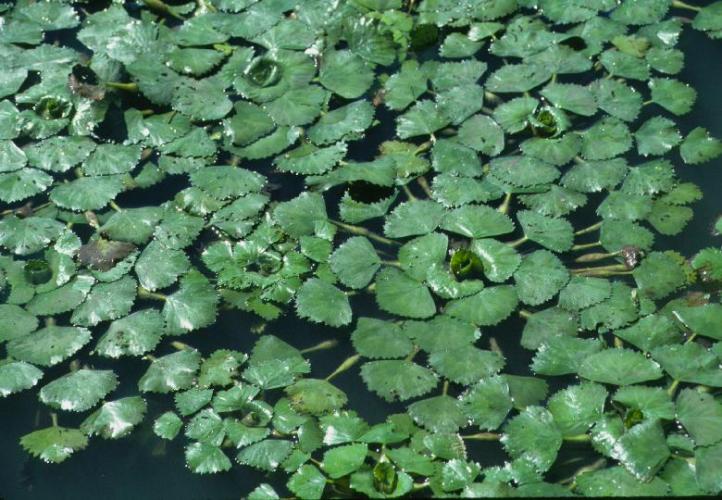Water Chestnut
Identification
This rooted annual has both submersed, and surface leaves. Surface leaves are toothed and triangular in shape, while submersed leaves are whorled and appear feathery. A white flower (four petals) blossoms (typically above water) from July until the season’s first frost. Stems can grow up to 4.8m long, and rosettes (leaves above water) can grow larger than dinner plates by the end of a growing season. Seeds are produced right under the rosettes, and will be green in color with four sharp spines characteristic to water chestnut fruit. Inflated petioles are present under the surfacing leaves.
Biology
Origin
Water chestnut is native to Europe and Asia.
Habitat
Water chestnut grows in freshwater of depths up to 4.8 m (16 ft). Prefers slow-moving water rich in nutrients. Prefers pH levels between 6.7 and 8.2.
LifeCycle
Water chestnut is an annual aquatic plant that grows from seed banks in sediment that overwinter and germinate during a future growing season. Each plant, emerging at the water’s surface in mid-May, consists of about 15-20 rosettes each of which can produce 15-20 seeds. Seeds take about one month to mature and sink to the sediment, remaining viable for up to 12 years. Introduction of water chestnut typically results from the seed’s barbs getting attached to waterfowl feathers or the fur of other animals, intentional planting, or aquarium release.
Ecological Threat
Water chestnut is a highly effective competitor in shallower waters, forming dense mats of plant matter if left unmanaged. These floating mats of water chestnut can create access issues for boaters and anglers, as well as other aquatic recreators. The species is very costly to manage due to its exponential reproduction techniques and characteristics such as its root system that make it difficult to remove. The spiny seed can be harmful to humans if stepped on.
Vermont Distribution
Southern Lake Champlain and some surrounding waterbodies have infestations of water chestnut. Check out the Vermont AIS map for the full distribution of water chestnut in the state.
How You Can Help
For most aquatic invasive species, humans are the primary vector of transport from one waterbody to another. Many of these nuisance plants and animals can be unknowingly carried on fishing gear, boating equipment, or in very small amounts of water in a watercraft. The easiest and most effective means to ensure that you are not moving aquatic invasives is to make sure that your vessel, as well as all your gear, is drained, clean, and dry.
BEFORE MOVING BOATS BETWEEN WATERBODIES:
-
CLEAN off any mud, plants, and animals from boat, trailer, motor and other equipment. Discard removed material in a trash receptacle or on high, dry ground where there is no danger of them washing into any water body.
-
DRAIN all water from boat, boat engine, and other equipment away from the water.
-
DRY anything that comes into contact with the water. Drying boat, trailer, and equipment in the sun for at least five days is recommended. If this is not possible, then rinse your boat, trailer parts, and other equipment with hot, high-pressure water.
Interested in monitoring for aquatic invasives?
- Join the VIPs! Vermont Invasive Patrollers help search for new infestations so we can respond immediately and prevent them from becoming established.
Citations
Bove, A., and T. Hunt. 1997. Water chestnut: An exotic plant invasion in Lake Champlain. Page 12 in Balcom, N.C, ed. Proceedings of the Second Northeast Conference on Nonindigenous Aquatic Nuisance Species, 18-19 April 1997, Burlington, VT. Connecticut Sea Grant College Program Publication CTSG-97-02. Groton, CT.
Crow, G.E., and C.B. Hellquist. 2000. Aquatic and Wetland Plants of Northeastern North America. Volume 1. Pteridophytes, Gymnosperms and Angiosperms: Dicotyledons. Volume 1. The University of Wisconsin Press, Madison, WI.
Gwathmey, J.H. 1945. Potomac River cleared of floating islands. Maryland Conservationist 22(1):21-23.
Kiviat, E. 1993. Under the spreading water-chestnut. News From Hudsonia 9(1):1-6.
Lake Champlain Basin Aquatic Invasive Species Guide.
Methe B.A., R.J. Soracco, J.D. Madsen, and C.W. Boylen. 1993. Seed production and growth of water chestnut as influenced by cutting. Journal of Aquatic Plant Management 31:154-157.
Midwest Invasive Species Information Network (MISIN) and Michigan Natural Features Inventory (MNFI). 2013. Water chestnut (Trapa natans).
Pemberton, R. W. 2002. Water Chestnut. Invasive Plant Research Laboratory, U.S. Department of Agriculture, Agricultural Research Service, Ft. Lauderdale, FL. Accessed 8 Aug, 2016
Pfingsten, I.A., L. Cao, and L. Berent.. 2016. Trapa natans. USGS Nonindigenous Aquatic Species Database, Gainesville, FL. Accessed 8 Aug, 2016
U.S. Army Corps of Engineers. April 2012. Accessed 8 August 2016.
Winne, W.T. 1950. Water chestnut: A foreign menace. Bulletin to the Schools 36(7):230-234.
